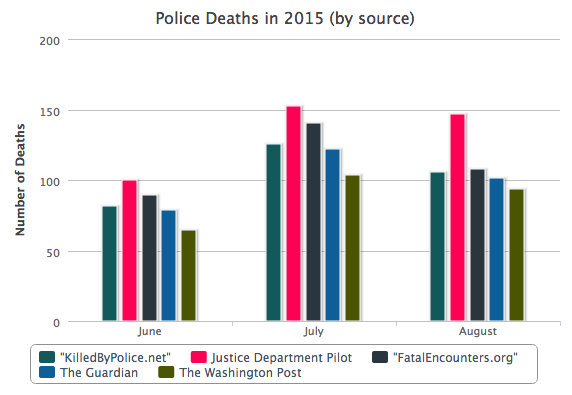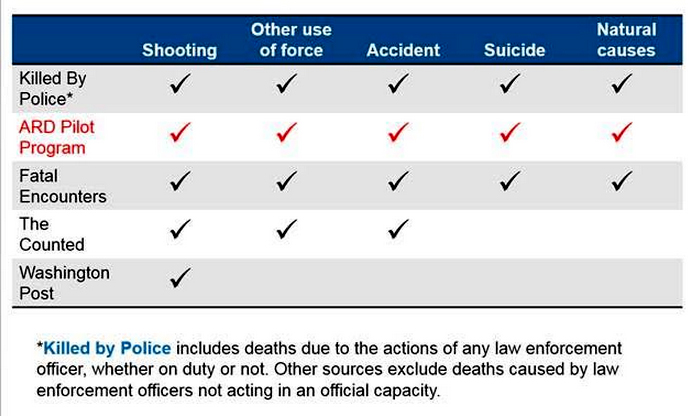Number of Deaths in Police Custody Higher than Media Reports: DOJ Data

FeyginFoto/Shutterstock.com
The story of police brutality has been missing one data point – a federal accounting of the problem.
The story of police brutality playing out on city streets, in news accounts and on cellphone video footage has been missing one data point – a federal accounting of the problem.
This spring, Justice Department-funded data scientists will present findings from a pilot project that, in essence, crowdsources facts on police homicides. So far, the number of possible deaths during and after police pursuit is far higher than the figures tabulated by both journalists and activists appalled by the longtime paucity of data on excessive use-of-force.
The project is part of a new project by the Bureau of Justice Statistics focused on capturing an official record of the whole “universe” of law enforcement homicides. The agency has assigned part of a new task to an artificial intelligence tool that crawls online news for the most relevant, potential cases of civilians dying during arrests. Soon, bureau data analysts will compare the reports to local agency records.
A survey in the offing will measure police body camera use nationwide.
"Because newspaper accounts will vary a lot in the elements that they cover, we don't have a great deal of confidence" that they will include every data element of interest, Bureau of Justice Statistics Director Bill Sabol told Nextgov.
Project leaders emphasize the census-taking does not rely on press accounts, but rather consults articles to "nominate" cases for follow-up with law enforcement, medical examiners and criminal investigative agencies.
Agencies’ "additional facts and circumstances may reveal a different cause of death,” Sabol said. Or, “somebody may have written a story about a homicide, but the homicide didn't occur.”
The end goal of this fact-finding mission, the government says, is to create a more efficient way of acquiring reliable details on the number of people killed by law enforcement.
Human rights groups say legitimate data will facilitate transparency and accountability when cops use unreasonable force.
The whole project is part of a larger departmentwide effort to put a credible number on the cases of use-of-force in the United States. There are no good figures on people severely harmed, shot at or killed by the police, partly because of the difficulty of coming up with common criteria to record for each situation.
Justice's "arrest-related deaths program" -- which has been in place since 2003 -- identified only between 59 and 69 percent of the estimated actual total of fatal interactions with police in 2011, according to a March 2015 bureau assessment of the program. The ongoing crowdsourcing and fact-checking process is a redesign of that program.
"Arrest-related deaths" encompass all fatalities -- not only homicides but also incidents like suicides and accidents -- that happen during pursuit of a suspect.
If the statistics bureau likes what it sees in the spring, a contract solicitation to maintain the system could be issued in time for reporting to begin in October.
Robo-Search Engine Picks Death News like Netflix Picks Movies
The push to offer citizens and government agencies a quantitative depiction of police brutality arrives during a low point for the public's trust in police.
The killing of black teenager Michael Brown two years ago by a white police officer in Ferguson, Missouri, became the tipping point for suspicions that U.S. authorities tend to pull the trigger disproportionately on black individuals.
More recently, the November 2015 release of a police dashboard camera video showing a white Chicago cop fatally shooting black teenager Laquan McDonald 16 times in 2014 prompted nationwide protests.
On Dec. 3, an FBI advisory policy board recommended the FBI collect data on the use of force by officers whenever their actions result “in death or serious bodily injury, or whenever a law enforcement officer discharges a firearm at or near an individual," FBI spokesman Stephen G. Fischer Jr. said in an emailed statement.
The figures would be amassed through the FBI’s longstanding Uniform Crime Reporting Program, he said. Those data elements, however, only partially overlap with the statistics bureau's informational needs.
So, about a year ago, the bureau began conversations with the FBI about creating a single questionnaire for local agencies that would combine both sets of statistical reporting.
Even if a single FBI form becomes a reality, the statistics bureau would maintain the crowdsourcing system as a type of check.
"If we find cases in Google Alerts and they are not appearing in the FBI data, then we could use that to follow up with agencies to confirm that, in fact, yes, the report is correct and the agency should submit a report," Sabol said. "We want to keep something going to make sure the coverage of all the eligible cases is complete."
Last summer, contractors from research institute RTI International developed the artificial intelligence technology that picks out news reports about arrest-related deaths.
The computer program winnows down an overwhelming amount of results from keyword searches ("police shooting" pulls up 7 million hits on Google) by dissecting the text of stories and matching this analysis with articles researchers previously read. It serves up news articles in a way similar to how Netflix suggests movie recommendations based on films a viewer watched in the past.
Humans Have the Ultimate Say-So
After a three-month tryout, the technique identified 400 possible arrest-related deaths, including homicides and other fatalities.
The number represents potential arrest-related deaths not yet confirmed and totals could be revised downward. For example, follow-up with local agencies might reveal that multiple articles about the same unnamed victims are double-counting police deaths, according to program managers.

Still, that government statistic is larger than figures calculated by high-profile, grassroots efforts to quantify police-involved deaths during the same time period.
The criteria measured by FatalEncounters.org hew closely to the bureau’s selections: shootings, other uses of force like taser homicides, accidents, suicides and natural causes. The organization found 339 deaths during that same time frame, from June 2015 through August 2015.
A Guardian newspaper project called “The Counted,” whose parameters are similar, but excludes suicides and natural causes, recorded 303 fatalities.
KilledbyPolice.net, which tracks all five types of deaths plus off-duty killings, logged 314 incidents.
The Washington Post's database of strictly police shootings resulting in deaths recorded 263 killings.
A team of humans at the bureau has the ultimate say-so in selecting potential cases, after reviewing the pool chosen by the machine-learning program, officials say.
Duren Banks, an RTI International criminologist and former bureau unit chief, said some of the technology in play is often used by commercial enterprises that want to gauge how often they are being talked about in the news and in what context.
"We've developed our own system to weave through that information and prioritize which media to look at specifically," she said.
The approach removes duplicate media reports, deaths in foreign countries and other articles outside the project's scope. It then ranks the hits in order of relevancy.
"We don't rely on blogs or information put out by partisan-type of groups," Banks said.
Staff members record the reported date of death, law enforcement agency involved and deceased individual's name, if disclosed.
During the fact-finding phase, the bureau will ask local agencies questions such as: Was the deceased armed? What might the individual have been charged with? How many law enforcement agencies responded to the scene? The bureau will take down the demographics of the person who died, including race and ethnicity, as well as whether the incident occurred in a private residence, public space or law enforcement facility.
A Long Wait for Meaningful Data
Some current and former police officers do not expect the final statistics to reflect that police brutality is pervasive in the United States.
With the FBI and the bureau data, "we can fill in some of the narrative because the narrative is being filled in anyway," said Mark A. Marshall, sheriff of Isle of Wight County, Virginia. While pundits in the media claim use-of-force by police is a systemic problem across law enforcement, "I would beg to differ,” he said.
"There are millions and millions of contacts involving citizens and the law enforcement that don’t end up in use-of-force applications, or certainly in deadly-force applications. They are relatively rare, but they do occur," said Marshall, who sits on the advisory board that recommended the FBI quantify such instances. "Anywhere those kinds of incidents occur, we’re all painted, whether it’s in Chicago, whether it's New York, or whether it's in Isle of Wight, Virginia, we all get painted with the same brush."
Without accurate long-term statistics, it is impossible to tell whether police abuse rates have increased or decreased from the time of, for example, the 1991 videotaped beating of Rodney King by L.A.P.D. officers to the 2014 surveillance video on YouTube of 12-year-old Tamir Rice slain by a Cleveland police officer.
There is speculation that police have exercised extreme force against civilians for decades, and the trend went undetected until body-cams, smartphone cameras and surveillance cameras sent images of misconduct viral.
Peter Kraska, who researches police militarization and holds a chair at Eastern Kentucky University’s School of Justice Studies, said: "It may be that it's infinitely better than it used to be, or it may be that it's infinitely worse. We just don't know.”

After starting to take stock in 2015, The Washington Post and the Guardian each reported that about 1,000 civilians were killed by cops last year.
For some perspective, during the 12-month period the statistics bureau last collected local agency records, which was in 2011, it counted 689 homicides by police.
Police Departments Don’t Have to Record
Law enforcement agencies are not required to report police killings to the FBI or the statistics bureau.
Most agencies have zero deaths each year, so the burden to participate is small, said Banks, the RTI criminologist. Some states actually mandate that agencies assemble and report the data. But for other agencies, primarily larger ones, the process does take effort and money.
Between 2003 and 2011, the bureau provided slightly more than $730,000 in assistance to states for gathering data through a centralized statistical analysis center, Banks said.
Kanya Bennett, American Civil Liberties Union legislative counsel, said there would be less “teeth pulling" if Justice tried more of a get-tough approach.
Justice has the option to dock a certain percentage of a police department's federal funding if it does not submit data on law enforcement homicides, under the Death in Custody Reporting Act, which governs the bureau's data collections.
"I think that it is important that the Bureau of Justice Statistics do its own independent gathering of information," Bennett said. "However, it should have a fairly good starting point if it were actually requiring police departments to report."
Many law enforcement agencies oppose tying performance metrics to federal dollars, arguing the loss of money will compromise public safety. But Bennett argued, "We should not be handing out federal dollars if we are not even getting the most basic of information about how police are doing their job with federal dollars.”
Statistics bureau officials, in 2010 and 2011, began requesting more data from local police departments dealing with specific cases that had garnered media coverage. After that, “participation increased,” officials told Nextgov in an email.
The current pilot study should serve as a “direct test” of police departments' ability to respond to questions about press accounts, officials said.
The bureau "is committed to working with state and local law enforcement agencies as well as the FBI to ensure" the program data is "reliable," their emailed statement said.
Because emotions are running high on the issue of excessive force, there is pressure to show society some hard and fast figures that might not turn out to be right, Marshall cautioned. At the statistics bureau, the fact-checking probably will create complications, he said, adding, "I just don’t know that that’s going to be an accurate number."
In the meantime, all 51 of Marshall's officers now are outfitted with body cameras.
"As I told our deputies, it captures the good, the bad and the ugly," he said. "If we’ve got things that we need to improve, if there are training issues, that gives us the accountability and the transparency."
It’s All About Context
The statistics bureau expects to survey about 5,000 law enforcement agencies early in 2016 on their body-cam use, policies and practices.
The agency, however, has not assessed incorporating video into its accounting of police-involved fatalities.
"We haven't given serious thought to whether body-cams or car-cams or other video could be used to capture information about the circumstances surrounding the deaths," said Sabol, the Bureau of Justice Statistics director. The variations in police department policies may rule out the use of video feeds as a data set, he said.
Nick Selby, a detective with a police department near Dallas, Texas, maintains a tally of law enforcement homicides with video accompaniment, when available, as a business. The data is available for free. He stressed that attaining a deep understanding of deadly situations will be critical for Justice.
"We need much more data than is currently being gathered, and the data must be around the context of the event -- from the 911 call to the autopsy and final investigative reports, grand jury and court testimony," said Selby, who was not speaking in his capacity as a detective.
His company, analytics firm StreetCred Software, logs "data on the officers -- any prior complaints of excessive force -- and the decedent -- any prior conviction of violent crime," he said.
For video to be valuable, it must be taped, tagged, stored and parsed.
Terry Gainer, a former Senate sergeant at arms, chief of the U.S. Capitol police and 20-year veteran of the Chicago Police Department, now consults organizations on body camera surveillance.
"It's the analytics that will let everybody decide whether law enforcement is hiring the right officer, whether we have the right policy, the right training, the right supervision,” he said.
(Image via FeyginFoto/Shutterstock.com)



